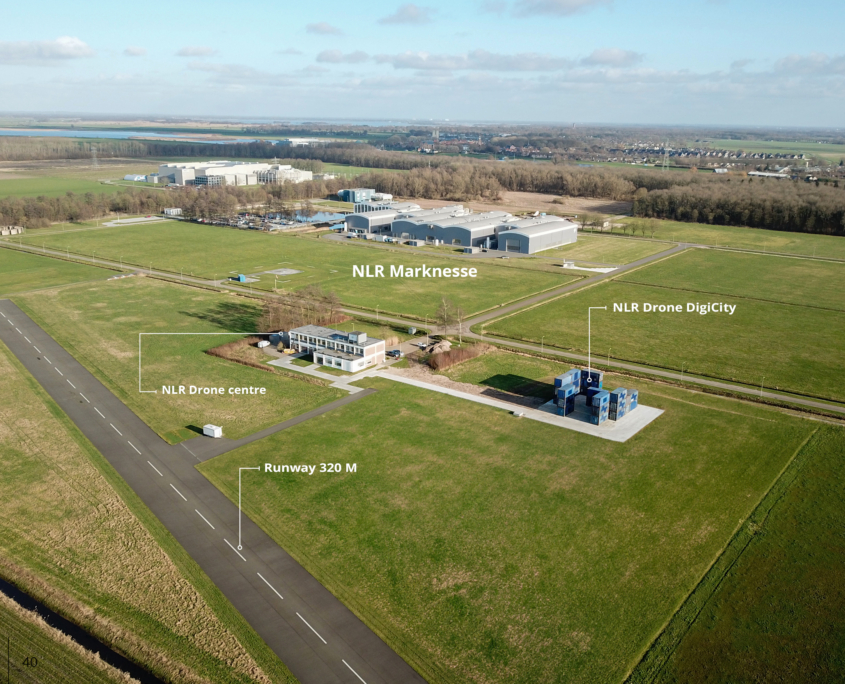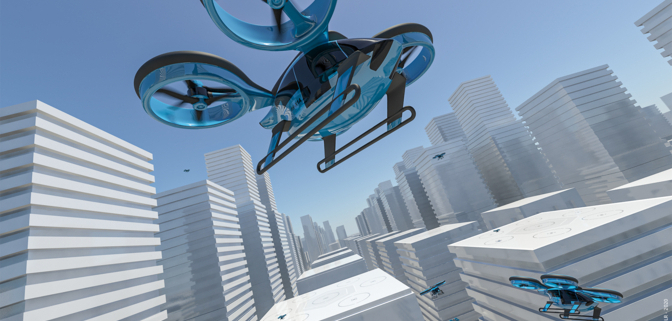Drones are becoming increasingly useful in our society – just think of all the drone flights for research, inspections and transport. The practical applications seem inexhaustible. There are still challenges for using this technology in urban areas and the added value that drones provide is by no means a given in terms of public acceptance. The NLR Drone DigiCity experimental environment is helping get applications that address this off the ground.
Drones have acquired a definite place in our current society. NLR has been making efforts for some years now to create safe, efficient and practical applications for these unmanned aircraft. As an addition to the NLR Drone Centre – with facilities that include its own workplace, a surfaced landing strip of over 320 metres and a closed airspace zone above the NLR premises in Marknesse – Drone DigiCity is now also officially opening its doors.
Experimentation and co-creation
Drone DigiCity is the new test facility at the NLR Drone Centre in Marknesse. External parties can carry out experiments here and test out their drones and related systems in a configurable simulated urban environment. They can also use the office workplaces and the workshop for this. This brings them directly into contact with other entrepreneurs and with NLR’s experts in drone technology, legislation and regulations and Innovative Air Mobility (IAM).
“Opening this centre means that NLR is offering all kinds of parties who work with drones – such as start-ups, SMEs and governmental institutions – the opportunity to develop their own concepts and check how they perform in practice,” explains Timo Nijman. He is NLR’s project leader for the new facility. “This will give customers an isolated environment with predetermined meteorological conditions and other relevant factors that lets them find out what impact the city has on their drones and what impact the drones have on the city.”
“NLR Drone DigiCity has a lot to offer the Dutch commercial sector,” says Ruud van Raak of Kansen voor West (Opportunities for the Western Region). “On top of having an isolated test environment with its own workplace, it’s a place where entrepreneurs can meet each other too. In that sense, it’s an ideal spot for combining forces. That’s an important reason why the Kansen voor West programme is supporting the project financially, helping strengthen the competitiveness of the SME sector in particular.” The collaboration between NLR and Shore Systems is a clear example of the role that the SME sector has in this initiative: the latter specialises in developing, designing and producing drones and is now closely involved with Drone DigiCity.
Smart city
The simulated urban environment consists of 24 shipping containers that can be placed in various configurations. To monitor this environment, a measurement system is being developed further with a high-tech digital infrastructure, sensors and measurement devices both in the city and on the airborne drones. The technical measurement and analysis room of Drone DigiCity is also located in the NLR Drone Centre.
Using inside knowledge
If drones are to be flown safely and efficiently in what may well be densely populated or complex areas, drone pilots will have to practice carrying out manoeuvres e.g. to avoid obstacles safely and to learn how to use specific navigation techniques. Strong and varying airflows around buildings are one of the challenges of flying in an urban environment. To learn what kinds of airflows the drones will have to tackle, NLR has carried out tests in a wind tunnel using a scale model of DigiCity. This has allowed the speed and wind directions of the air to be mapped out accurately every 25 cm over the entire height of DigiCity, which is nearly 8 m tall.
Perceptions of noise
Noise nuisance is another important factor, of course, as well as safety. The technical measurement and analysis room of DigiCity is also located in the NLR Drone Centre. Assessing how ‘city-proof’ the drones are will show what is still needed for realising safe and practical applications of them in cities.
Integration
Adding the aerial element and the rise of IAM (including autonomous vehicles in an urban environment) are new challenges for mobility in the future. A great deal more research is needed if safety and a balanced quality of life are to be guaranteed for airspace users. An experimental environment such as Drone DigiCity provides concrete evidence for creating a picture of what is realistically feasible and what will be acceptable in the cities of the future. The parties involved want to help simplify the licensing process and reduce the time to market.
NLR Drone DigiCity is being realized through a subsidy from Kansen voor West in the context of REACT EU and NLR.



 Bundeswehr
Bundeswehr